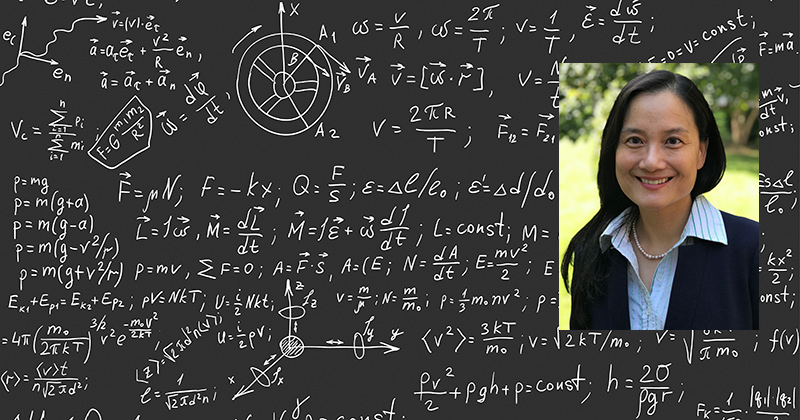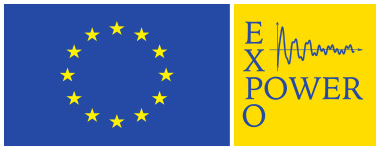


The power of exponents
February 10, 2022
UD mathematician is part of international research team awarded European Union grant
People sometimes use the word “exponential” in conversation to mean “very fast,” says the University of Delaware’s Miao-Jung Yvonne Ou, but for mathematicians who are working in the field, the process can be just the opposite.
“Multi-exponential analysis is an important field of mathematics,” said Ou, an applied mathematician who has worked to develop mathematical and computational methods to study such conditions as osteoporosis and Alzheimer’s disease. “But when designing algorithms for solving exponential analysis problems, progress is usually not so fast because of the intrinsic mathematic difficulty underlying these problems.
“These sets of equations can be very complex and difficult to solve. It can take years of work.”
The associate professor of mathematical sciences is now part of an international team of researchers that has received a prestigious European Union Research and Innovation Staff Exchange grant. Their project, known as EXPOWER for Exponential Analysis Empowering Innovation, encompasses eight universities, three research institutes and seven companies from nine countries; UD and the U.S. National Institutes of Health (NIH) are the only institute members in the United States.

Led by Annie Cuyt, a professor at the University of Antwerp and a member of the Royal Flemish Academy of Belgium, the project combines a broad range of research and training activities using multi-exponential analysis with applications in industry. The EU grant of over $900,000 (in U.S. dollars) covers research from 2021 to 2025.
Multi-exponential analysis has been described as ubiquitous in mathematics, as almost all functions use the exponential function ez as a building block. In that function, “e” is a constant known to mathematicians as the Euler number, and z is a complex number. When z is restricted to be the real numbers x, the function e-rx is said to decrease or decay exponentially at rate r. In many applications, the goal is to identify the exponential decay rates hidden in the given data, which is usually a weighted sum of exponential functions with various decay rates.
In simple terms, Ou said, multi-exponential analysis can be used to produce a curve from a given set of data points and to find the increase/decay rates hidden in the curve. For example, to show the change in air temperature over a day, a person could take a thermometer reading every hour, plot the numbers on a graph and draw lines connecting the points. But even if the temperature is taken every minute—or every second—the graph will still consist of a series of straight connecting lines, even if each one is very short. To produce a smooth curve, multi-exponential analysis can be applied to the data set, in a procedure called the Prony’s interpolation.
In Ou’s own research on osteoporosis, she has used this type of mathematical analysis to study how the deterioration of the microstructure of porous materials, such as the osteoporotic bones, can be quantified using ultrasound data.
After several years of work, she found the mathematical link between the bone microstructure and the equations modeling ultrasound wave propagation.
“There is something very complicated about your bones, so that waves sent through the wrist bone present a difficult problem to solve,” she said. “To understand the progression of osteoporosis, you can’t just eyeball the x-ray images of bones. You need a mathematical way to look at it.”
She has also been working with colleagues at NIH to monitor the progression of Alzheimer’s disease by applying multi-exponential analysis to the nuclear magnetic resonance (NMR) data.
“Multi-exponential analysis might sound remote, but it touches our daily lives in many surprising ways, even if most people are unaware of how important it is,” the EXPOWER project says on its website. “For example, a substantial amount of effort in signal processing and time series analysis is essentially dedicated to the analysis of multi-exponential functions. Multi-exponential analysis is also fundamental to several research fields and applications … [including] remote sensing, antenna design, digital imaging, testing and metrology, all impacting some major societal or industrial challenges such as energy, transportation, space research, health and telecommunications.”
Ou and other mathematicians working with exponential analysis often conferred over the years, particularly because the field and its research problems are so interdisciplinary.
“We all work in different areas, but when we began coming together for conferences and meetings, we realized this was a big topic and a growing area of interest,” she said. “That’s when we decided to apply for the grant.”
A meeting is scheduled for May 2022 at ASTRON, the Netherlands Institute for Radio Astronomy, with participants hoping not only to collaborate but also to bring new young researchers into the field.
“This work takes many people and many different tools,” Ou said. “We need as many different perspectives as we can get.”
More information about the project and the grant can be found at the EXPOWER website.
Contact Us
Have a UDaily story idea?
Contact us at ocm@udel.edu
Members of the press
Contact us at 302-831-NEWS or visit the Media Relations website

